What happens if you feed ants steroids? o.O
- Formiculture.com
- Forums
- Gallery
- Members
- Member Map
- Chat

What happens if you feed ants steroids? o.O
What happens if you feed ants steroids? o.O
That is the best question I've heard all day!
What happens if you feed ants steroids? o.O
That is the best question I've heard all day!
Good question. I have no clue, and I am certainly not about to use them on a colony that is growing this fast. They might decide to take over my 27 gallon fish aquarium as well.
"Always do right. This will gratify some people, and astound the rest." -- Samuel Clemens
Yeah that Formicarium aint going to last you two years ![]() !
!
That is crazy growth for Camponotus!
Currently Keeping:
Trachymyrmex septentrionalis
Pheidole pilifera
Forelius sp. (Monogynous, bicolored) "Midwestern Forelius"
Crematogaster cerasi
Pheidole bicarinata
Aphaenogaster rudis
Camponotus chromaiodes
Formica sp. (microgena species)
Nylanderia cf. arenivega
Very cool Journal! I can't believe how fast they've grown in such a short amount of time. Love the natural look of your formicarium as well great job!
More growth has occurred. They have brood in all stages, I don't see any eggs at this point though.
After some heavy feeding in anticipation of a trip, they all have distended gasters.
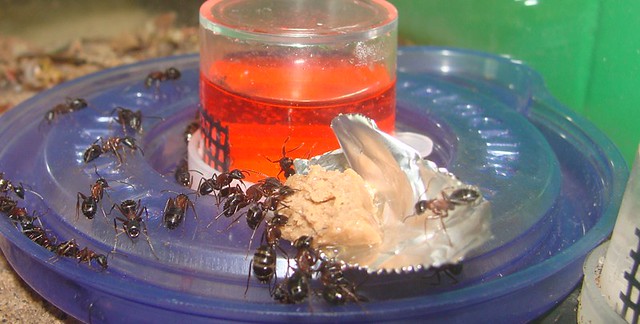
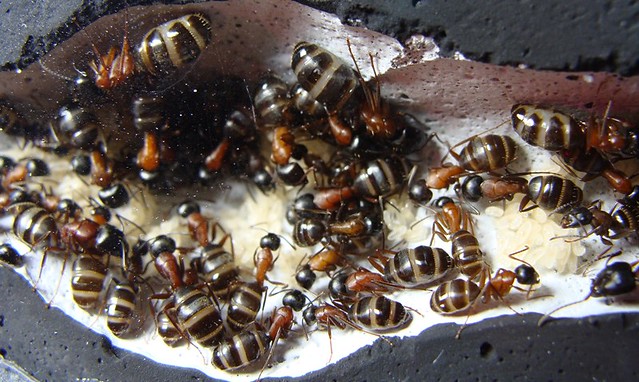
Edited by Crystals, December 28 2017 - 9:08 AM.
"Always do right. This will gratify some people, and astound the rest." -- Samuel Clemens
They are definitely preparing for hibernation. 95% of them are in the coldest part of the nest with the small and medium larvae. About a dozen are tending 4-6 larger larvae and a pupae. Once these have pupated and eclose I will put them into hibernation. Everyone has distended gasters and foraging is very low, although I do have 4-5 guarding the nectar feeder.
They did scatter a bit when I took the photo.
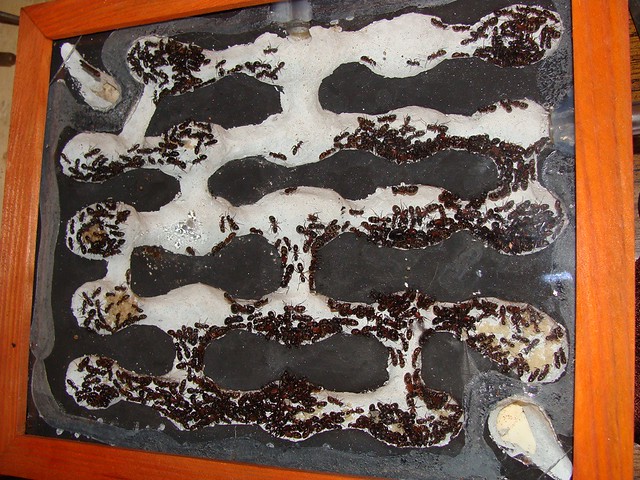
Edited by Crystals, December 28 2017 - 9:09 AM.
"Always do right. This will gratify some people, and astound the rest." -- Samuel Clemens
Holy that's a lot of Camponotus I don't think I ever seen that many in one photo ![]()
These gals are now in hibernation. I have not seen any larvae growth for weeks and 98% of the colony is avoiding the heat cable.
I have never had such a hard time getting all of the workers out of the foraging area and into the nest. After several days testing various methods, such as stuffing them to the point they ignored food, high light levels, dark nest, no heat cable, etc. I still had 20 or so foragers that refused to give in. All of my smaller colonies go into the nest and ignore the foraging area when they want to hibernate.
In the end I tilted the foraging area down from the connecting tubing and misted the foraging area until 70% of the ground was covered in water. Still some persisted in exploring their new environment, walking on the sand under water.... After 3 hours of misting all but 7 were in the nest, so I grabbed my feather weight forceps, ice cold water, and a cotton ball. I misted them with ice water to slow them, then grabbed them and stuffed them into the tubing. After about 3min I managed to get all 7 inside at once and I quickly plugged the tubing.
I watered the nest heavily and stuck them in the cooler. I am not looking forward to the next hibernation period when the colony is larger. I was not aware of how persistent the larger colonies were even when they are ready for hibernation.
"Always do right. This will gratify some people, and astound the rest." -- Samuel Clemens
If the gasters expand more they will turn into honey pot ants. ![]()
If the gasters expand more they will turn into honey pot ants.

rofl Good one. Yes, soon they can compete. ![]()
"Always do right. This will gratify some people, and astound the rest." -- Samuel Clemens
They came out of hibernation today. I don't see any dead workers, which is a first for any larger colony coming out of hibernation.
Let's see what this season has in store for this colony. ![]()
"Always do right. This will gratify some people, and astound the rest." -- Samuel Clemens
All overwintered larvae spun cocoons within a couple of weeks of coming out of hibernation.
The queen laid one small batch of eggs the first 2 weeks which are now medium sized larvae. About 50 or so over a 2 week span.
The last 4 days the queen has started laying a huge batch of eggs. The egg pile, if combined, is the size of a marble. It looks like some of the eggs are starting to hatch, but it is difficult to see as they are so tiny.
Nest Overview:
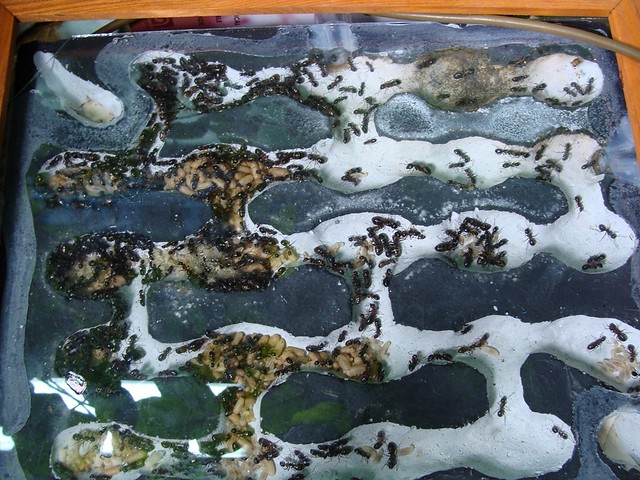
Piles of pupae: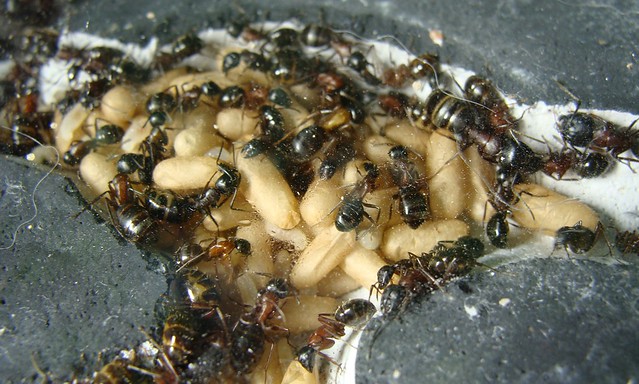
Part of the egg pile: (sorry for the blurry photo and dirty glass)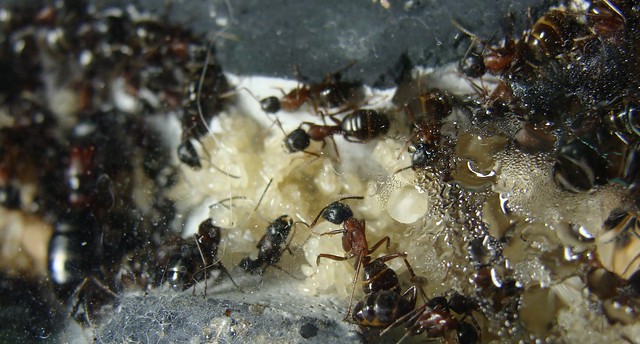
Edited by Crystals, December 28 2017 - 9:11 AM.
"Always do right. This will gratify some people, and astound the rest." -- Samuel Clemens
Holy looks like this year will be a good growth year for this Colony ![]()
It is looking that way. Despite feeding 3-5 mealworms/crickets a day and a tablespoon of nectar every 2-3 days their gasters are not distended.
I didn't include a picture of the foraging area as it is a bit dirty, but it has about 50 ants roaming around looking for even more food.
"Always do right. This will gratify some people, and astound the rest." -- Samuel Clemens
I don't know where they are putting all of this food.
They have doubled their nectar intake, drinking almost a tablespoon of nectar a day. They can eat 2 large mealworms in under 3 hours and look for more. I have been giving them 2-3 mealworms and 2-4 medium-large crickets everyday and they are plowing through it like a snack. I am likely going to have to increase their rations again until their spring growth spurt is over.
I offered them a krill from a left over fishing trip and after the 2 minute freak out session they started drinking the juices.
The brood pile has grown dramatically, almost doubling in size. Likely a combination of more eggs being laid and from eggs hatching into larvae.
"Always do right. This will gratify some people, and astound the rest." -- Samuel Clemens
Lots of pupae are eclosing, and there are lots of larvae approaching cocooning size.
Not to mention hundreds of very small larvae and eggs as well. I will have to post a picture later. They are starting to fill up this nest pretty quickly - the nest looks almost twice as full as it was on March 28.
It seems that there are 3 distinct batches - the pupae, the mid/large larvae, and the tiny larvae/eggs. The pupae and larger larvae are mixed up in their piles, with some piles of pure pupae. The eggs and newly hatched larvae are in a separate location in the nest.
"Always do right. This will gratify some people, and astound the rest." -- Samuel Clemens
Update!
Bit late, but here are the pictures from May 2016, just before they went into hibernation.
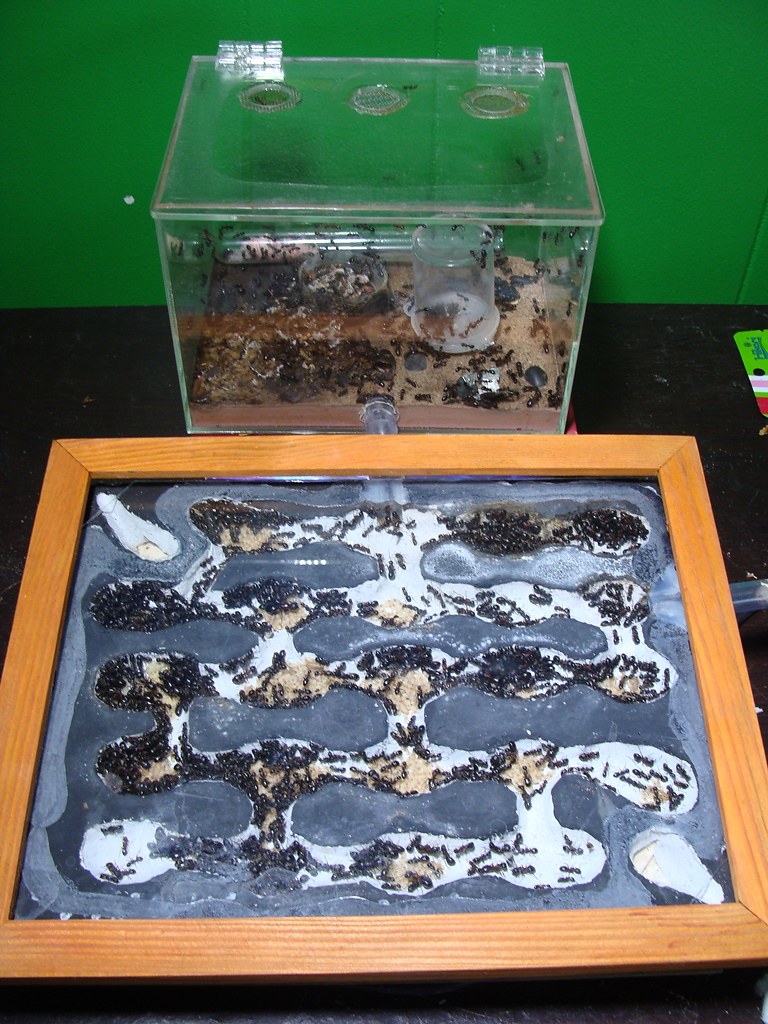
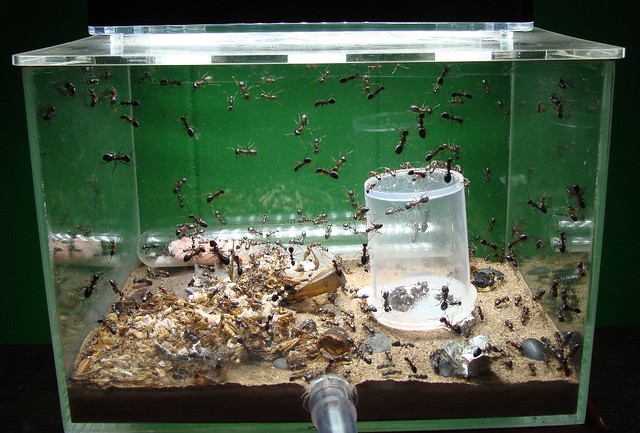
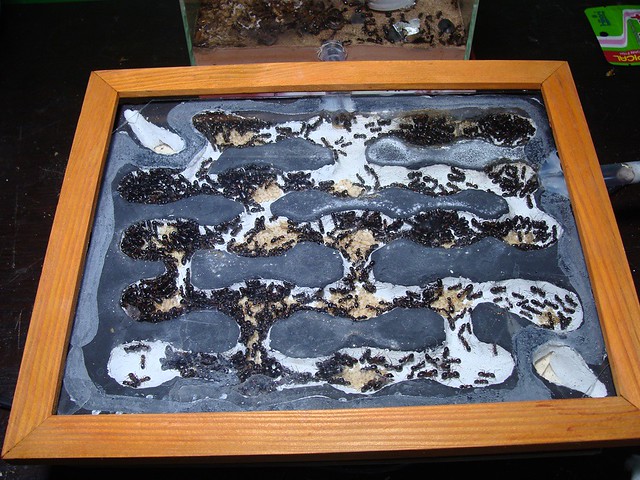
They are overwintering lots of larvae this time. The guards in the foraging area have also decided that they don't want to go back into the nest... Yeah, I know the foraging area needs a serious cleaning.
These ants have also picked up a new bad habit. They like to chew on the edge of the vinyl tubing. Thankfully they hadn't chewed it enough to escape, but it was close by the time I noticed it.
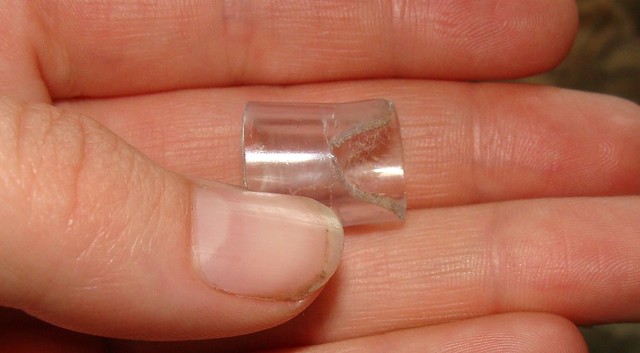
They just re-entered hibernation as of July 1st.
Edited by Crystals, December 28 2017 - 9:18 AM.
"Always do right. This will gratify some people, and astound the rest." -- Samuel Clemens
 |
Ant Keeping →
Ant Keeping Journals →
cooIboyJ's Nylanderia vividula journalStarted by cooIboyJ , Sep 6 2025 |
|

|
|
Ant Keeping →
Ant Keeping Journals →
Ants_Dakota's Camponotus sp. JournalStarted by Ants_Dakota , Jul 13 2025 |
|

|
||
Ant Keeping →
Ant Keeping Journals →
Strickys Formica JournalStarted by stricky_ants , Jun 21 2025 |
|
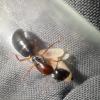
|
||
Ant Keeping →
Ant Keeping Journals →
AntTx's Camponotus sansabeanus JournalStarted by AntsTx , Jun 17 2025 |
|

|
||
Ant Keeping →
Ant Keeping Journals →
RmA's 2nd Camponotus Crusade (Updated 9/21/'25)Started by RushmoreAnts , Jun 3 2025 |
|

|
0 members, 1 guests, 0 anonymous users